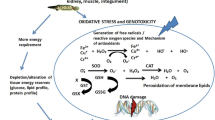Abstract
Concentrations of ten trace elements (Hg, As, Cd, Pb, Co, Cr, Cu, Ni, Se and Zn) were determined in different tissues (liver, kidney, muscle, heart and brain) of African sacred ibis (Threskiornis aethiopicus), Hamerkop (Scopus umbretta), marabou stork (Leptoptilos crumeniferus) and great white pelican (Pelecanus onocrotalus) inhabiting the Ethiopian Rift Valley region. There were differences in trace element patterns among the bird species. Significantly (p < 0.05) higher concentrations of Cd (5.53 µg/g dw ± 2.94) in kidney and Hg (0.75 µg/g ww ± 0.30) in liver were observed in the great white pelican compared to the other species, and liver concentrations of these two elements showed positive correlations with trophic level. Concentrations of toxic elements (As, Cd, Pb and Hg) in liver were below their respective toxicological thresholds, indicating that the data may provide baseline information for future studies.

Similar content being viewed by others
References
Birdlife International (2013) Country profile: Ethiopia http://www.birdlife.org/datazone/userfiles/file/IBAs/AfricaCntryPDFs/Ethiopia.pdf
Burger J, Gochfeld M (2000) Effects of lead on birds (Laridae): a review of laboratory and field studies. J Toxicol Environ Health B Crit Rev 3:59–78
Burger J, Gochfeld M (2002) Effects of chemicals and pollution on seabirds. In: Schreiber EA, Burger J (eds) Biology of marine birds. CRC, NewYork, pp 492–525
Cabana G, Rasmussen JB (1994) Modelling food chain structure and contaminant bioaccumulation using stable nitrogen isotopes. Nature 372:255–257
Carpenter JW, Andrews GA, Nelson Beyer W (2004) Zinc toxicosis in a free-flying trumpeter swan (Cygnus buccinator). J Wildl Dis 40:769–774
Clark AJ, Scheuhammer AM (2003) Lead poisoning in upland foraging birds of prey in Canada. Ecotoxicology 12:23–30
Eisler R (1986) Chromium hazards to fish, wildlife and invertebrates: a synoptic review. Biological report 85 (1.6). U.S. Fish and Wildlife Service, Washington
Eisler R (1987) Mercury hazards to fish, wildlife and invertebrates: a synoptic review. Biological report 85 (1.10). U.S. Fish and Wildlife Service, Washington
Eisler R (1994) A review of arsenic hazards to plants and animals with emphasis on fishery and wildlife resources. In: Nriagu JO, Simmons MS (eds) Arsenic in the environment. Part II: human health and ecosystem effects. Wiley, New York, pp 185–259
Furness RW (1993) Birds as monitors of pollutants. In: Furness RW, Greenwood JJD (eds) Birds as monitors of environmental change. Chapman and Hall, London, pp 86–143
Furness RW (1996) Cadmium in birds. In: Beyer WN, Heinz GH, Redmon-Norwood AW (eds) Environmental contaminants in wildlife: interpreting tissue concentrations. Lewis Press, Boca Raton, pp 389–404
Goyer AR (1997) Toxic and essential metal interactions. Ann Rev Nutr 17:37–50
Heinz GH (1996) Selenium in birds. In: Beyer WN, Heinz GH, Redmon-Norwood AW (eds) Environmental contaminants in wildlife: interpreting tissue concentrations. Lewis Press, Boca Raton, pp 447–458
Ikemoto T, Kunito T, Tanaka H, Baba N, Miyazaki N, Tanabe S (2004) Detoxification mechanism of heavy metals in marine mammals and seabirds: interaction of selenium with mercury, silver, copper, zinc, and cadmium in liver. Arch Environ Contam Toxicol 47:402–413
Kim EY, Murakami T, Saeki K, Tatsukawa R (1996) Mercury levels and its chemical form in tissues and organs of seabirds. Arch Environ Contam Toxicol 30:259–266
Kojadinovic J, Le Corre M, Cosson RP, Bustamante P (2007) Trace elements in three marine birds breeding on Reunion Island (Western Indian Ocean) part 1: factors influencing their bioaccumulation. Arch Environ Contam Toxicol 52:418–430
Kunito T, Kubota R, Fujihara J, Agusa T, Tanabe S (2008) Arsenic in marine mammals, seabirds, and sea turtles. Rev Environ Contam Toxicol 195:31–69
Levina A, Codd R, Dillon CT, Lay PA (2003) Chromium in biology: nutritional aspects and toxicology. Prog Inorg Chem 51:145–250
Lucia M, André JM, Gonzalez P, Baudrimont M, Gontier K, Maury-Brachet R, Davail S (2009) Impact of cadmium on aquatic bird Cairina moschata. Biometals 22:843–845
Lucia M, André JM, Gontier K, Diot N, Veiga J, Davail S (2010) Trace element concentrations (mercury, cadmium, copper, zinc, lead, aluminium, nickel, arsenic, and selenium) in some aquatic birds of the Southwest Atlantic Coast of France. Arch Environ Contam Toxicol 58:844–853
Lucia M, Bocher P, Cosson RP, Churlaud C, Bustamante P (2012) Evidence of species-specific detoxification processes for trace elements in shorebirds. Ecotoxicology 21:2349–2362
Mateo R, Green AJ, Lefranc H, Baos R, Figuerola J (2007) Lead poisoning in wild birds from southern Spain: a comparative study of wetland areas and species affected, and trends over time. Ecotoxicol Environ Saf 66:119–126
Nam DH, Anan Y, Ikemoto T, Tanabe S (2005) Multielemental accumulation and its intracellular distribution in tissues of some aquatic birds. Mar Pollut Bull 50:1347–1362
Pain D, Sears J, Newton I (1995) Lead concentrations in birds of prey in Britain. Environ Pollut 87:173–180
Ralston NVC, Blackwell JL, Raymond LJ (2007) Importance of molar ratios in selenium dependent protection against methylmercury toxicity. Biol Trace Elem Res 119:255–268
Scheuhammer AM (1987) The chronic toxicity of aluminium, cadmium, mercury, and lead in birds: a review. Environ Pollut 46:263–295
Scheuhammer AM, Meyer MW, Sandheinrich MB, Murray MW (2007) Effects of environmental methylmercury on the health of wild birds, mammals, and fish. Ambio 36:12–18
Skoric S, Visnjic-Jeftic Z, Jaric I, Djikanovic V, Mickovic B, Nikcevica M, Lenhardt M (2012) Accumulation of 20 elements in great cormorant (Phalacrocorax carbo) and its main prey, common carp (Cyprinus carpio) and Prussian carp (Carassius gibelio). Ecotoxicol Environ Saf 80:244–251
Snoeijs T, Dauwe T, Pinxten R, Vandesande F, Eens M (2004) Heavy metal exposure affects the humoral immune response in a free-living small songbird, the great tit (Parus major). Arch Environ Contam Toxicol 46:399–404
Varian-Ramos CW, Swaddle JP, Cristol DA (2014) Mercury reduces avian reproductive success and imposes selection: an experimental study with adult- or lifetime-exposure in zebra finch. PLoS ONE 9(4):e95674. doi:10.1371/journal.pone.0095674
Yohannes YB, Ikenaka Y, Nakayama SMM, Ishizuka M (2014) Organochlorine pesticides in bird species and their prey (fish) from the Ethiopian Rift Valley region, Ethiopia. Environ Pollut 192:121–128
Zhang WW, Ma JZ (2011) Waterbirds as bioindicators of wetland heavy metal pollution. Procedia Environ Sci 10:2769–2774
Acknowledgements
This study was supported by a Grant-in-Aid for Scientific Research from the Ministry of Education, Culture, Sports, Science, and Technology of Japan awarded to M. Ishizuka (No. 16H01779, Core to Core), Y. Ikenaka (No. 26304043) and S. Nakayama (No. 16K16197). We would also like to acknowledge the financial support of the Soroptimist Japan Foundation and the Nakajima Foundation. The authors are grateful to EWCA senior experts, Mr. Yeneneh Teka and Dr. Fekede Regassa, for their assistance with bird sampling. We also appreciate Mr. Lemma Abera for his kind help during sampling, as well as Mr. Takahiro Ichise for his technical input.
Author information
Authors and Affiliations
Corresponding author
Rights and permissions
About this article
Cite this article
Yohannes, Y.B., Ikenaka, Y., Nakayama, S.M.M. et al. Trace Element Contamination in Tissues of Four Bird Species from the Rift Valley Region, Ethiopia. Bull Environ Contam Toxicol 98, 172–177 (2017). https://doi.org/10.1007/s00128-016-2011-4
Received:
Accepted:
Published:
Issue Date:
DOI: https://doi.org/10.1007/s00128-016-2011-4




